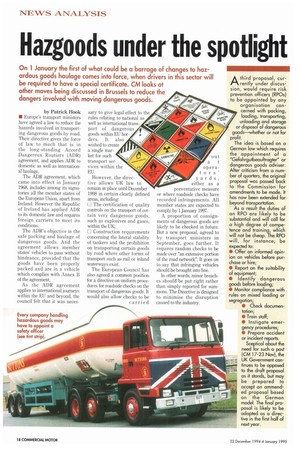Hazgoods under the spotlight
Page 20

If you've noticed an error in this article please click here to report it so we can fix it.
On 1 January the first of what could be a barrage of changes to hazardous goods haulage comes into force, when drivers in this sector will be required to have a special certificate. CM looks at other moves being discussed in Brussels to reduce the dangers involved with moving dangerous goods.
by Patrick Hook
• Europe's transport ministers have agreed a law to reduce the hazards involved in transporting dangerous goods by road. Their directive gives the force of law to much that is in the long-standing Accord Dangereux Routiers (ADR) agreement, and applies ADR to domestic as well as international haulage.
The ADR agreement, which came into effect in January 1968, includes among its signatories all the member states of the European Union, apart from Ireland. However the Republic of Ireland has applied ADR to its domestic law and requires foreign carriers to meet its conditions.
The ADR's objective is the safe packing and haulage of dangerous goods. And the agreement allows member states' vehicles to pass without hindrance, provided that the goods have been properly packed and are in a vehicle which complies with Annex B of the agreement.
As the ADR agreement applies to international journeys within the EU and beyond, the council felt that it was neces sary to give legal effect to the rules relating to national as well as international transport of dangerous goods within EU borders. It also wished to create a single market for such transport services within the EU.
However, the directive allows UK law to remain in place until December 1998 in certain clearly defined areas, including: Li The certification of quality controls on the transport of certain very dangerous goods, such as explosives and gases, within the UK; O Construction requirements concerning the lateral stability of tankers and the prohibition on transporting certain goods by road where other forms of transport such as rail or inland waterways exist.
The European Council has also agreed a common position for a directive on uniform procedures for roadside checks on the transport of dangerous goods. It would also allow checks to be carried
a t operators' yards, either as a preventative measure or where roadside checks have recorded infringements. All member states are expected to comply by 1 January 1997.
A proportion of consignments of dangerous goods are likely to be checked in future. But a new proposal, agreed to by transport ministers in September, goes further. It requires random checks to be made over "an extensive portion of the road network". It goes on to say that infringing vehicles should he brought into line.
In other words, minor breaches should be put right rather than simply reported for summons. The Directive is designed to minimise the disruption caused to the industry.




















































































































